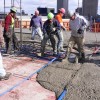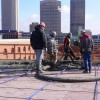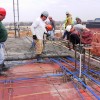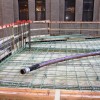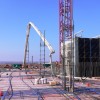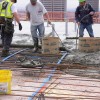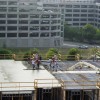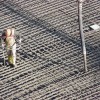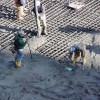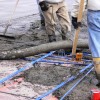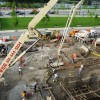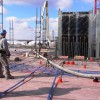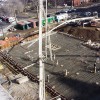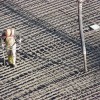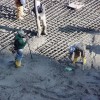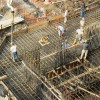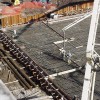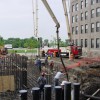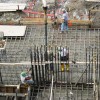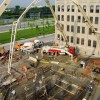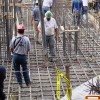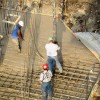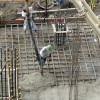Specialty Placed Concrete
There are several Specialty, or non-traditional, methods of Placing Concrete. These methods can offer economic advantages in terms of site preparation, the need for accessories and equipment, and reduced labor costs. Properly applied, Shotcrete, a sprayed concrete, is a durable construction material that bonds strongly with earth, rock, steel and existing concrete. Shotcrete is easily applied, its formwork assemblies are often simpler than in conventional placement, and less material is used, since the layers of sprayed concrete are thinner. Pumped Concrete and Pneumatically Placed Concrete also involve the delivery of concrete as a spray from either a dry or wet mix. Both methods utilize pumps, primarily the mechanical type for the pumped concrete, whereas pneumatic placement uses compressed air. For sites that are difficult to access, or at which space is limited, these methods are practical alternatives to conventional concrete placement.

Topic Summary
Underwater Placed Concrete is used for the construction of bridge piers and for repairs and renovation of existing concrete structures. Here the concrete mix needs to be highly workable and cohesive, and contact with water or moisture prior to placement needs to be prevented. Different methods for placing concrete underwater are available and they are all designed to prevent cement washout and the resultant inferior concrete. One method that is fairly widely used is the tremie process, in which concrete is gravity-fed through a tube (tremie). Roller-Compacted Concrete has emerged as a rapid and relatively economical method for the placement of concrete. In this method, the concrete is placed in layers (similar to asphalt paving) and rolled with the same equipment used for asphalt paving.
The versatility of concrete is exemplified by its application as countertops for kitchens and bathrooms. Cast-in-place concrete countertops are less complicated and generally less expensive than the pre-cast structures. For imaginative people, the shapes of the countertops may be limited only by the ability to construct the required formwork. Furthermore, with the many stains, pigments and aggregates that are available today, countertops can be designed and built in a wide range of colors.
Description and Uses
Shotcrete is the term used to describe concrete that is sprayed at high velocity onto a surface, and as a consequence, is simultaneously placed and consolidated. This technique is used in the construction of tunnels, building foundations, sea walls, parking garages, and for bridge rehabilitation and the repair and restoration of concrete. As sprayed, Shotcrete would be a brittle material. The concrete mix is therefore reinforced by the addition of glass, steel, or plastic fibers, and this mix is sprayed onto properly located reinforcing steel or welded wire fabric reinforcing.
Both pumped concrete and pneumatically placed concrete can be used for the construction of most structural elements. The mix needs to have the ability to flow, and yet it must be highly cohesive, readily allowing for placement, compaction, and finishing processes. Both methods use pumps to form the spray of concrete, with pneumatic placement using a compressed air pump rather than a mechanical pump, as is used for pumped concrete.
In Underwater Placed Concrete, it is necessary that the concrete avoid substantial contact with water, and it is also necessary that the concrete does not segregate. If the concrete mix is no longer homogeneous (as could result if the concrete were simply placed by dropping it from a substantial height), the result would be inferior concrete. Therefore, special placement systems and processes, such as the tremie process, are used.
Roller-compacted concrete (RCC) is now used for the construction of dams, parking and storage areas, off-highway projects, and as a base for conventional pavement. The method uses an essentially zero-slump concrete, which has a consistency like damp gravel, containing local aggregates or crushed, recycled concrete, cement, and water. Formwork assemblies and finishing, surface texturing, joint sawing (“concrete cutting”), and sealing processes are not necessary with roller-compacted concrete.
For building a countertop, the concrete is usually reinforced with welded steel wire fabric, and traditional methods are used to place the concrete after the reinforcement has been located.
Methods and Materials
Shotcrete is applied as a dry mix or a wet mix. In the dry mix the cement and aggregate are premixed and moistened before being conveyed to the spray gun. Compressed air is also supplied to the gun to deliver the mixture through a hose to the nozzle. Water and admixtures are introduced through a perforated ring in the nozzle into the concrete mixture, and the operator controls the amount of water introduced. The dry mix method uses either a “double chamber” or a “continuous feed” gun.
In the wet mix method, ready-mixed concrete is either mechanically or pneumatically pumped to the gun and compressed air is simultaneously injected to provide the required velocity. Again there are two types of guns used, the pneumatic feed gun and the positive displacement gun.
Using the dry mix method, the Shotcrete is typically applied at a rate that is 4-5 times slower than that using the wet mix method and the “rebound,” i.e., the concrete that rebounds from the surface during spraying, can be significantly less. Using the wet mix normally produces less waste and forms less dust. The output from concrete pumps ranges from 15 to 150 cubic yards per hour, but the effective capacity depends on the total system, i.e., the line length, the number of bends, the height to which the concrete is pumped and the concrete mixture itself.
When the project requires pumped concrete or pneumatically placed concrete, the pumps themselves may be mounted on either a truck or a trailer and moved to the site.
The lines from the pump to the placement area consist of rigid steel or plastic pipes and flexible rubber sections. The fine aggregates in the concrete mix are better graded than in a standard mix, and the cement content is higher. Oversized particles of the coarse aggregate should be eliminated, with the maximum diameter of these particles being less than one-third the smallest inside diameter (ID) in the pump and 40% of the diameter of the smallest pipe in the lines. Admixtures are used to improve workability and provide easier pumping.
The concrete used for Underwater Placed Concrete is necessarily a highly workable and cohesive mix. It typically contains Portland cement and fly ash, with natural sand and natural gravel, in a sand to gravel ratio of 0.45. The concrete is protected from exposure to water until it is placed using either tremie pipes or a pump.
A basic tremie process is as follows:
- Drive a form pipe or hollow tube to the desired depth below grade - e.g. 50'-0".
- Ensure that there is no dirt in the pipe. Typically an auger is used to remove earth/soil. The pipe will in most cases fill with ground water.
- Install appropriate reinforcing.
- Place the tremie pipe inside the other pipe and lower the tremie pipe to 45'-0". There will be, in most cases, water in the temie pipe.
- Place a ball in the top of the tremie pipe and start pumping concrete into the tremie pipe, on top of the ball. As the ball descends due to the weight of the concrete, it will prevent water from mixing with the concrete.
- The ball will exit the bottom of tremie pipe and float to the surface, and the concrete will exit the tremie pipe and start filling the form pipe from the bottom, forcing the water out the top as the level of the concrete rises.
- As the level of concrete is increasing, the tremie pipe will be raised, ensuring that the lower end always stays in the concrete.
Both tremie and pumped concrete placement methods have advantages and disadvantages. The latter method is simpler and requires less equipment. Furthermore, pumping lines are more maneuverable and the area of concrete in contact with water is often minimized using a pump.
A different approach, used in particular to repair underwater concrete structures, is to initially place coarse aggregate into the form and then inject grout to fill the voids in the aggregate. Referred to as pre-placed aggregate (PA), the material bonds strongly to the existing concrete, is durable, and has been used effectively for bridge piers and abutments.
A continuous flow system is frequently used to mix roller-compacted concrete. After being transported to the site, the concrete is placed in layers with a standard asphalt spreader and then compacted with a vibratory, steel-wheeled and pneumatic roller. Water, as a fine mist, is immediately applied to the surface and it is covered and left to cure.
The concrete used to build countertops can contain a large proportion of aggregates, which can significantly affect the appearance of concrete countertops. For example, a coarse aggregate can be exposed by grinding or polishing and it is therefore important to select the right particle size and shape to obtain the required appearance. The color of the countertop is also affected by the aggregate, and here the fine materials have a more marked effect than the coarse ones. In selecting either gray or white cement for the concrete mix, it should be realized that the latter is more easily colored with pigments, stains, tints or dyes. There will always be some variation in the color of the countertop, since concrete is not a uniform, homogeneous material. The subtle differences in color and pattern, which can be aesthetically pleasing, depend upon the materials used, the casting (“concrete placement”) and curing processes, and the finishing techniques. Finally, a sealer is applied to give the surface a gloss, satin, matte or flat appearance.

Buildipedia Staff
The Buildipedia research and writing staff consists of dozens of experienced professionals from many sectors of the industry, including architects, designers, contractors, and engineers.
Website: buildipedia.com/
